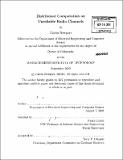Distributed computation on unreliable radio channels
Author(s)
Newport, Calvin (Calvin Charles)
DownloadFull printable version (11.98Mb)
Other Contributors
Massachusetts Institute of Technology. Dept. of Electrical Engineering and Computer Science.
Advisor
Nancy Lynch.
Terms of use
Metadata
Show full item recordAbstract
An important topic in wireless networking is the development of reliable algorithms for environments suffering from adversarial interference. This term captures any type of channel disruption outside the control of the algorithm designer-from contention with unrelated devices to malicious jamming. In this thesis, we provide four contributions toward a comprehensive theoretical treatment of this topic. First, we detail a formal modeling framework. This framework is general enough to describe almost any radio network studied to date in the theory literature. It can also precisely capture the often subtle details of adversarial behavior. In addition, we prove a pair of composition results that allow a layered strategy for designing radio network algorithms The results can be used to combine an algorithm designed for a powerful channel with an implementation of this channel on a less powerful channel. Next, we formalize adversarial interference with the definition of the t-disrupted channel. We then define the more powerful (t, b, p)-feedback channel, and provide both a randomized and deterministic implementation of the latter using the former. To emphasize the utility of this layered approach, we provide solutions to the set agreement, gossip, and reliable broadcast problems using the powerful feedback channel. Combined with the implementation algorithms and composition results, this automatically generates solutions to these problems for the less powerful, but more realistic, t-disrupted channel. Finally, we define a variant of the modeling framework that captures the attributes of an ad hoc network, including asynchronous starts and the lack of advance knowledge of participating devices. (cont.) Within this new framework, we solve the wireless synchronization problem on a t-disrupted channel. This problem requires devices to agree on a common round numbering scheme. We conclude by discussing how to use such a solution to adapt algorithms designed for the original model to work in the ad hoc variant.
Description
Thesis (Ph. D.)--Massachusetts Institute of Technology, Dept. of Electrical Engineering and Computer Science, 2009. Cataloged from PDF version of thesis. Includes bibliographical references (p. 169-175).
Date issued
2009Department
Massachusetts Institute of Technology. Department of Electrical Engineering and Computer SciencePublisher
Massachusetts Institute of Technology
Keywords
Electrical Engineering and Computer Science.